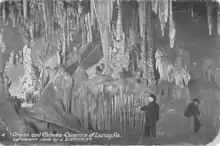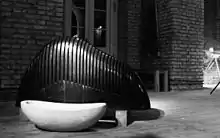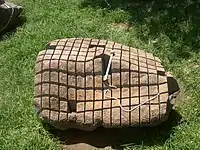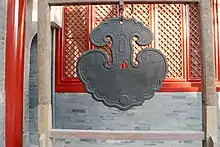Lithophone
A lithophone is a musical instrument consisting of a rock or pieces of rock which are struck to produce musical notes.[1] Notes may be sounded in combination (producing harmony) or in succession (melody). The lithophone is an idiophone comparable to instruments such as the glockenspiel, vibraphone, xylophone and marimba.


In the Hornbostel-Sachs classification system, lithophones are designated as '111.22' – directly-struck percussion plaques.
Notable examples
- A rudimentary form of lithophone is the "rock gong", usually a natural rock formation opportunistically adapted to produce musical tones, such as that on Mfangano Island, in Lake Victoria, Kenya. The Great Stalacpipe Organ of Luray Caverns, Virginia, USA uses 37 stalactites to produce the Western scale. Another stalactite lithophone is to be found at Tenkasi in South India. Ringing Rocks Park in Pennsylvania is another well known lithophone.
- A typical Basque instrument named Txalaparta (or Chalaparta) can be made of wood or stone, but is traditionally made of wood
A more sophisticated lithophone trims and mounts individual stones to achieve a full-scale idiophone:
- Probable prehistoric lithophone stones have been found at Sankarjang in Odisha, India.[2]
- Vietnamese lithophones dating back to ancient times, called đàn đá, have been discovered and revived in the 20th century.
- The ritual music of Korea features the use of stone chimes called pyeongyeong, derived from the Chinese bianqing.
- The Musical Stones of Skiddaw from Cumbria, England have been made into an instrument placed at Keswick Museum and Art Gallery.
- A lithophone called the Musical Stones has been created at Brantwood, the former home of John Ruskin in Cumbria, England, and may be played there by visitors.[3]
- The Silex Piano, circa 1885, employed suspended flints of various sizes which were struck with other flints to produce sounds.
- Composer-vibraphonist Wolfgang Lackerschmid uses an instrument called the gramorimba, which is featured alongside the vibraphone and marimba in a trio setting.
- Icelandic post-rock band Sigur Rós played a slate marimba, which sculptor Páll Guðmundsson constructed from rocks found in Iceland.[4] This is demonstrated in their DVD Heima.[5]
- The stone marimba.
- The hōkyō, a lithophone invented in Japan, has been made from the bars of sanukite.[6]
- The German composer Carl Orff calls for a lithophone called Steinspiel in his later works.
- Some lithophones include electric pickups to amplify the sounds.
Lithophone as Architectural Element
- Ancient Indians were perhaps the first to use man-made lithophones as architectural elements. Temples like Nellaiyappar temple (8th century) in Tirunelveli, Vijaya Vitthala temple (15th century) in Hampi, Madurai Meenakshi temple (16th century) and Suchindram Thanumalayan temple (17th century) have musical pillars.[7]
Stone marimba
A stone marimba is configured in the same manner as the more typical wooden bar marimba. The bars are usually wide like a wooden marimba, but are thinner, which helps increase resonance. The stone marimba may or may not have resonators.
A stone marimba housed at the Musée de l'Homme is possibly the oldest-known musical instrument on the planet.[8]
.JPG.webp) Lithophone made of Phonolite in the botanic garden in Schellerhau (Germany)
Lithophone made of Phonolite in the botanic garden in Schellerhau (Germany).jpg.webp) Ethiopian Lithophones with Stand, Monastery of Na’akuto La’ab
Ethiopian Lithophones with Stand, Monastery of Na’akuto La’ab.jpg.webp) Stone marimba, range C3–C5
Stone marimba, range C3–C5 Stone xylophone
Stone xylophone Stone chimes, Shandong Provincial Museum, Jinan
Stone chimes, Shandong Provincial Museum, Jinan
See also
References
- Diagram Group. (1976). Musical instruments of the world. Published for Unicef by Facts On File. p. 121. ISBN 0871963205. OCLC 223164947.
- P. Yule/M. Bemmann, Klangsteine aus Orissa Die frühesten Musikinstrumente Indiens?, Archaeologia Musicalis 2.1, 1988, 41–50 (also in English and French); Paul Yule, Rätsel indischer Kultur, in: H.-G. Niemeyer - R. Pörtner (eds.), Die großen Abenteuer der Archäologie (Salzburg 1987) vol. 10, p. 3739 ISBN 385012150X.
- "Musical Stones: Rock music from the Cumbrian Hills". Brantwood Trust. Archived from the original on 28 January 2013. Retrieved 6 January 2013.
- http://pallg.is/default.asp?sid_id=327&tre_rod=005%7C&tId=1
- A clip of Sigur Rós playing the slate marimba can be found here: https://www.youtube.com/watch?v=Lk3D5431SPs
- Prasad, M.G.; Rajavel, B. "Musical pillars and singing rocks" (PDF). Taranga. Retrieved 28 January 2018.
- The stones of Ndut Lieng Krak. New Scientist. 10 January 1957. p. 8. Retrieved 5 January 2013.
External links
| Wikimedia Commons has media related to Lithophones. |
- The British composer Will Menter invented the llechiphone, a marimba with keys made of slate, while working in North Wales.
- UK Musician, Tony Dale developed a resonated slate lithophone in 1984 featured by composer John Hardy.
- Other slate lithophones, called stonaphones, are made in the U.S. state of Maine by Jim Doble out of recycled slate roofing.
- An installation in Quark Park by Perry Cook and Jonathan Shor, consisting of 17 bars stretched over a 35-foot (11 m) long path.
- Audio and video of Stalacpipe Organ on Sound Tourism site
- lithophones.com Photographs, audio clips, and videos of lithophones from around the world, historical and contemporary.
